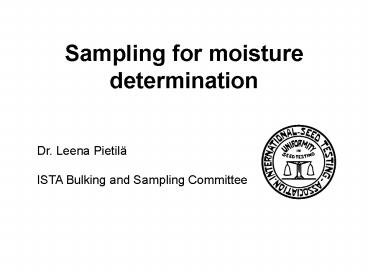Sampling for moisture determination - PowerPoint PPT Presentation
1 / 15
Title:
Sampling for moisture determination
Description:
The sub-sample for moisture determination must be done in ... Foil or polythene bags that can be heat-sealed. Glass or polythene bottles with an airtight top ... – PowerPoint PPT presentation
Number of Views:519
Avg rating:3.0/5.0
Title: Sampling for moisture determination
1
Sampling for moisture determination
Dr. Leena Pietilä ISTA Bulking and Sampling
Committee
2
ISTA Rules and sampling for moisture determination
- The sub-sample for moisture determination must
be done in such a way that changes in moisture
content are minimal (2.5.1.5) - Submitted samples must be dispatched to the seed
laboratory without delay (2.5.1.6)
3
The Rules and sampling for moisture determination
- The seed may not be exposed to the air during
sample reduction for more than 30 seconds
(2.5.2.2 9.1.5.2) - Take first the sub-sample for moisture
determination from the composite sample - Mixing by stirring the sample with a spoon
- OR Pour the sample back and forth between two
containers (9.1.5.2). The openings of the
containers need to be of similar size.
4
Taking a sub-sample for moisture determination
- Take at minimum three spoonfuls (2.5.2.2
9.1.5.2) - As much air as possible must be excluded from the
container (2.5.1.6 9.1.5.1), e.g. the
container must be filled to the brim
5
Examples of containers that are used for samples
for moisture determination
- Re-sealable plastic bags
- Foil or polythene bags that can be heat-sealed
- Glass or polythene bottles with an airtight top
- It may be worth of testing whether the container
is moisture proof
6
Sample reduction
- The ISTA Rules describe eight different sample
reduction methods - The ISTA methods must be followed, if the aim is
to issue an ISTA certificate
7
Sample reduction
- If the composite sample is too big, it must be
reduced to a size prescribed in the Rules - Before reduction, the composite sample need to be
mixed - Chaffy species three times, non-chaffy species
two times
8
Sample reduction
- No mixing before reduction is needed, if rotary
divider or variable sample divider are used - All the composite sample must be reduced
9
Instruments for sample reduction
- sample dividers
- by hand
10
Working quality of sample dividers
- Working quality of sample dividers must be
checked regularly - ISTA Handbook on Seed Sampling (Chapter 6.6)
gives guidance - Also other methods are used e.g. comparison of
the halved samples with ISTA tolerance tables
(Tables 3.3, 4.1, 5.2)
11
Checking working quality of dividers (ISTA
Handbook on Seed Sampling)
- Prepare a standard sample by mixing two kind of
seeds - E.g. 20 of small seeded species, 80
large-seeded species - Reduce the sample to 1/8
- Take one of the 1/8, separate the different seeds
by a sieve and weigh the fraction - Re-combine the fractions
- Repeat 9 times
12
Soil divider
- Results shows that reduction made by different
persons may give different results - It may be useful that working quality of the
- soil divider and persons doing the reduction are
checked regularly
13
Hand halving method
- Strictly restricted to the genera that are listed
in the Rules (2.5.2.2.4) - Trees and shrubs Acer, Aesculus, Ailanthus,
Castanea, Cedrela, Corylus, Fraxinus, Juglans,
Liriodendron, Platanus, Populus, Quercus, Salix,
Tectona, Ulmus - For all other species it can be used only to
obtain a working sample for health tests
14
Spoon method
- Recommended method sample reduction for seed
health testing - Can be used for all the seeds smaller than wheat
- Seed is taken at least from five random places
15
Thank you for your attention!































